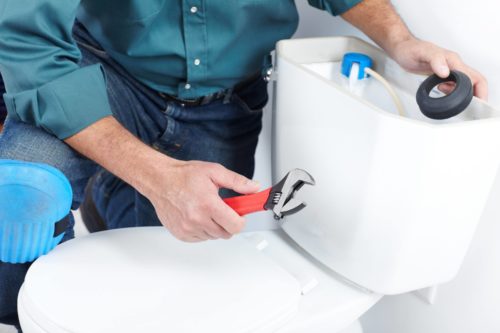
Indoor plumbing is a modern convenience that most of us take for granted, but when we get a stubborn toilet clog, it can be a little frightening. Flush toilets have worked more or less the same way for centuries, and they work by releasing a large volume of water into the bowl at once. If there’s a clog, that water can quickly spill over and create a big mess. There are a number of different materials that can clog up your pipes and several different techniques for breaking up those clogs. It should also come as no surprise that you’re less likely to encounter clogs if you can avoid flushing excess amounts of toilet paper and hygiene products. Even products that are labeled biodegradable and flushable can create clogs if a large family flushes them regularly.
Here are a few common causes of toilet clogs and backflows in the home.
- Excess amounts of paper or solid waste
- Insufficient water pressure
- Damaged or improperly installed toilet
- Deep clogs in the pipes
- Roots or other blockages
Some clogs are caused by problems so deep in the pipes that they require professional equipment to resolve. If that’s ever the case, our team at Beyer Plumbing is always here to help! We’ve been offering residential and commercial plumbing services in San Antonio, TX, since 1990, and our commitment to legendary service is bigger than Texas! Contact us any time that you have questions or if you need to schedule professional plumbing services. Here are also a few things that you can do to deal with some of those stubborn clogs on your own.
Use Your Plunger
The household plunger is one of the most inexpensive and effective tools that you have to deal with a stubborn clog. It forms a tight seal that enables you to push air through the pipes and force the water and waste through the blockage. It does require a lot of patience and no shortage of “elbow grease,” but doesn’t require an excessive amount of strength. In fact, you should also teach your children how to use the plunger to save yourself a lot of future heartache. You don’t have to buy the most expensive plunger on the shelf, but look for one with a flange because they form a better seal and are the most effective at unblocking toilets.
Good plunger technique is a bit more art than science, but you should start by pressing the plunger against the opening. If you have a plunger with a flange, the flange should slip into the crevice to form a tighter seal. Make sure that your first few plunges are smooth and gentle to avoid splashes and overflow. It’s never a bad idea to spread some towels around the floor before you get started, but a huge pile of wet towels is another mess to clean up after you unclog your toilet.
Be sure to maintain a seal as you compress on the plunger. Think of it like using a syringe, because the process is the same. If you don’t see the water draining freely after you lift up the plunger, you might want to lift the plunger out of the water to push some more air through the line. Be patient and repeat the process as many times as necessary until you free up the clog. Be sure to test flush the toilet several times before use, and listen for any unusual sounds when you plunge your toilet.
Vinegar and Baking Soda
You probably already know that chemical drain openers can damage your pipes if you use them too much. They’re also not something that most households always keep on hand. But most kitchens have vinegar and baking soda. Vinegar is a great non-toxic household cleaner, and baking soda is great as a deodorizer and cleaning product. The chemical reaction that happens when they’re mixed together does much more than help children make volcanoes for science fair projects. It dissolves organic materials and creates a pressurized gas. In addition to breaking up your blockages, it can also absorb odors and kill bacteria.
Just add a cup of baking soda to your blocked toilet and allow it to sit for a few minutes. Then you can add two cups of vinegar to begin the chemical reaction. Pour the vinegar carefully and slowly to prevent splashing, and allow the baking soda and vinegar mixture to work for a couple of minutes. You might need to repeat the process a couple of times before you hear a fast suction sound and the water begins to flush normally.
Hot Water and Dishwasher Detergent
Another great way to clear a clog is to use a mixture of hot water and dish soap. All that you have to do is boil a gallon of water and add about a cup of dish soap to your toilet bowl while the water is heating up on the stove. You don’t have to bring the water to boiling, but you should make sure that it’s piping hot. If the water is too hot, you run the risk of damaging your toilet’s wax seal and causing leaks. Allow the dish soap to sit in the toilet for about 10-15 minutes, and add the water slowly to avoid splashing. Be sure to protect your hands and keep your children out of the way. You can also use hot water from the sink or the shower and a bottle of inexpensive shampoo in a pinch.
Household Bleach
Household bleach is a more targeted weapon in the battle against clogs, but less corrosive on your pipes than chemical drain openers. Use the same technique as you use with dishwasher detergent, but replace the detergent with 2-3 cups of household bleach. Always use the necessary safety precautions when using bleach and avoid prolonged exposure to bleach in poorly ventilated spaces.
Household Toilet Snake
A snake is another great chemical-free tool to break up clogs that run deeper than the floor flange and a modest time investment for your home. Using a snake takes a little practice, but if it saves you the cost of one service call, it will pay for itself. Even though a wire hanger might seem like an acceptable substitute, it does more harm than good. It’s not long enough to make a difference, and it can scratch up your porcelain.
Professional Plumbing in San Antonio
You should always know your limitations when it comes to breaking up clogs or fixing other problems with your toilet or your plumbing. These DIY solutions are all very effective, but sometimes you’ll encounter a deep clog that requires equipment and expertise that’s beyond the range and scope of even the handiest homeowner. There’s no shame in calling a plumber when you encounter a clog that you can’t handle on your own.
Our team at Beyer Plumbing has been offering plumbing services in San Antonio, TX, and the surrounding areas for over 30 years, and we’re always as happy to see our customers as they are to see us! We have State Licensed and Certified plumbers with centuries of combined experience, and we’re fully accredited by the Better Business Bureau (BBB). Contact us 24 hours a day when you have any questions or if you’d like to schedule a service appointment!


